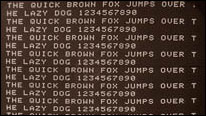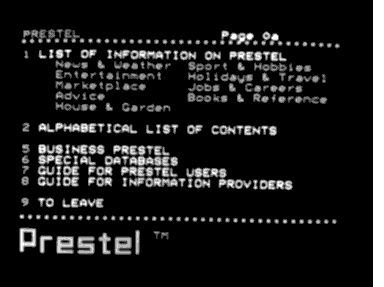|
CEEFAX
Ceefax () was the world's first teletext information service and a forerunner to the current BBC Red Button service. Ceefax was started by the BBC in 1974 and ended, after 38 years of broadcasting, at 23:32:19 BST (11:32 PM BST) on 23 October 2012, in line with the digital switchover completion in Northern Ireland. Pete Clifton Points of View 9 November 2008Test Cards and Ceefax BBC Archive To receive a desired page of text on a teletext-capable receiver, the user entered a three-digit page number on the device. The selected page was displayed on the user's screen as it was transmitted, requiring a wait of several seconds. There were many pages to choose from, and they could be displayed either on a black background or superimposed over the broadcast programme picture. This latter feature m ... [...More Info...] [...Related Items...] OR: [Wikipedia] [Google] [Baidu] |
Teletext
Teletext, or broadcast teletext, is a standard for displaying text and rudimentary graphics on suitably equipped television sets. Teletext sends data in the broadcast signal, hidden in the invisible vertical blanking interval area at the top and bottom of the screen. The teletext decoder in the television buffers this information as a series of "pages", each given a number. The user can display chosen pages using their remote control. In broad terms, it can be considered as Videotex, a system for the delivery of information to a user in a computer-like format, typically displayed on a television or a dumb terminal, but that designation is usually reserved for systems that provide bi-directional communication, such as Prestel or Minitel. Teletext was created in the United Kingdom in the early 1970s by John Adams, Philips' lead designer for video display units to provide closed captioning to television shows for the hearing impaired. Public teletext information services were ... [...More Info...] [...Related Items...] OR: [Wikipedia] [Google] [Baidu] |
Ceefax
Ceefax () was the world's first teletext information service and a forerunner to the current BBC Red Button service. Ceefax was started by the BBC in 1974 and ended, after 38 years of broadcasting, at 23:32:19 BST (11:32 PM BST) on 23 October 2012, in line with the digital switchover completion in Northern Ireland. Pete Clifton Points of View 9 November 2008Test Cards and Ceefax BBC Archive To receive a desired page of text on a teletext-capable receiver, the user entered a three-digit page number on the device. The selected page was displayed on the user's screen as it was transmitted, requiring a wait of several seconds. There were many pages to choose from, and they could be displayed either on a black background or superimposed over the broadcast programme picture. This latter feature m ... [...More Info...] [...Related Items...] OR: [Wikipedia] [Google] [Baidu] |
Analog Television
Analog television is the original television technology that uses analog signals to transmit video and audio. In an analog television broadcast, the brightness, colors and sound are represented by amplitude, instantaneous phase and frequency, phase and frequency of an analog signal. Analog signals vary over a continuous range of possible values which means that electronic noise and interference may be introduced. Thus with analog, a moderately weak signal becomes Noise (video), snowy and subject to interference. In contrast, picture quality from a digital television (DTV) signal remains good until the signal level drops below digital cliff, a threshold where reception is no longer possible or becomes intermittent. Analog television may be wireless (terrestrial television and satellite television) or can be distributed over a cable network as cable television. All broadcast television systems used analog signals before the arrival of DTV. Motivated by the lower bandwidth requ ... [...More Info...] [...Related Items...] OR: [Wikipedia] [Google] [Baidu] |
World System Teletext
World System Teletext (WST) is the name of a standard for encoding and displaying teletext information, which is used as the standard for teletext throughout Europe today. It was adopted into the international standard ITU-R, CCIR 653 (now ITU-R BT.653) of 1986 as CCIR Teletext System B. Development WST originally stems from the UK standard developed by the BBC and the UK Independent Broadcasting Authority in 1974 for teletext transmission, extended in 1976 as the Broadcast Teletext Specification. With some tweaks to allow for alternative Teletext character set, national character sets, and adaptations to the NTSC 525-line system as necessary, this was then promoted internationally as "World System Teletext". It was accepted by ITU-R, CCIR in 1986 under international standard CCIR 653 (now ITU-R BT.653) as one of four recognised standards for teletext worldwide (most commonly referred to as CCIR Teletext System B). WST in Europe Almost all television sets sold in Europe since the ... [...More Info...] [...Related Items...] OR: [Wikipedia] [Google] [Baidu] |
Channel 5 (UK)
5 (formerly known as Channel 5 and Five) is a British free-to-air public broadcast television channel owned and operated by Channel 5 Broadcasting Limited, a wholly-owned subsidiary of Paramount Global's UK and Australia division. It was launched in 30 March 1997 to provide a fifth national terrestrial channel in the United Kingdom. Channel 5 was renamed Five, from 16 September 2002 until 13 February 2011. Most of this was under the RTL Group's ownership with Richard Desmond purchasing the channel on 23 July 2010 and reverting the name change.'Mini-revamp planned for Channel 5 News' ATV Network, 30 October 2010 On 1 May 2014, the channel was acquired by Viacom (now Paramount Glo ... [...More Info...] [...Related Items...] OR: [Wikipedia] [Google] [Baidu] |
Channel 4
Channel 4 is a British free-to-air public broadcast television channel owned and operated by Channel Four Television Corporation. It is state-owned enterprise, publicly owned but, unlike the BBC, it receives no public funding and is funded entirely by its commercial activities, including Television advertisement, advertising. It began its transmission in 1982 and was established to provide a fourth television service in the United Kingdom. At the time, the only other channels were the television licence, licence-funded BBC1 and BBC2, and a single commercial broadcasting network, ITV (TV network), ITV. Originally a subsidiary of the Independent Broadcasting Authority (IBA), the station is now owned and operated by Channel Four Television Corporation, a public corporation of the Department for Culture, Media and Sport, which was established in 1990 and came into operation in 1993. Until 2010, Channel 4 did not broadcast in Wales, but many of its programmes were re-broadcast ther ... [...More Info...] [...Related Items...] OR: [Wikipedia] [Google] [Baidu] |
ITV (TV Network)
ITV, legally known as Channel 3, is a British free-to-air public service broadcasting in the United Kingdom, public broadcast television network. It is branded as ITV1 in most of the UK except for central and northern Scotland, where it is branded as STV (TV channel), STV. It was launched in 1955 as Independent Television to provide competition to BBC Television (established in 1936). ITV is the oldest commercial network in the UK. Since the passing of the Broadcasting Act 1990, it has been Legal name, legally known as Channel 3 to distinguish it from the other analogue channels at the time: BBC1, BBC2 and Channel 4. ITV was, for decades, a network of separate companies that provided regional television services and also shared programmes among themselves to be shown on the entire network. Each franchise was originally owned by a different company. After several mergers, the fifteen regional franchises are now held by two companies: ITV plc, which runs ITV1, the ITV1 cha ... [...More Info...] [...Related Items...] OR: [Wikipedia] [Google] [Baidu] |
Freeview (UK)
Freeview is the United Kingdom's sole Digital terrestrial television in the United Kingdom, digital terrestrial television platform. It is operated by Everyone TV and DTV Services Ltd, a joint venture between the BBC, ITV plc, ITV, Channel Four Television Corporation, Channel 4, Channel 5 Broadcasting Limited, 5 and Sky UK, Sky. It was launched on 30 October 2002, taking over the licence from ITV Digital which collapsed that year. The service provides consumer access via an Television antenna, aerial to the Digital terrestrial television in the United Kingdom#The multiplexes, seven DTT multiplexes covering the United Kingdom. As of July 2020, it has 85 TV channels, 26 digital radio channels, 10 HD channels, six text services, 11 streamed channels, and one interactive channel. Delivery of standard-definition television and radio is labelled Freeview, while delivery of HDTV is called Freeview HD. Reception of Freeview requires a DVB-T/DVB-T2 Tuner (television), tuner, either in a ... [...More Info...] [...Related Items...] OR: [Wikipedia] [Google] [Baidu] |
Sky Digital (UK & Ireland)
Sky UK Limited (formerly British Sky Broadcasting Limited (BSkyB)), Trade name, trading as Sky, is a British broadcasting, broadcaster and telecommunications company that provides television, broadband internet, fixed line and mobile telephone services to consumers and businesses in the United Kingdom. It is a subsidiary of Sky Group (currently owned by Comcast) and is headquartered at the Sky Campus, Sky Studios in Isleworth. Sky is a major media company and the largest British broadcaster by revenue. It operates the Sky News news media organisation, Sky Sports which is the largest sports TV broadcaster in the UK, and the Sky Studios film and TV production company. Sky is also the country's leading provider of Pay television, pay-TV services (12.7 million customers as of the end of 2019) through its satellite television, satellite TV platform Sky Q as well as the IPTV-based Sky Glass and Sky Stream products. Its flagship channels include Sky Showcase, Sky Max, Sky Witness, Sky ... [...More Info...] [...Related Items...] OR: [Wikipedia] [Google] [Baidu] |
Last Second Of BBC Ceefax
A last is a mechanical form shaped like a human foot. It is used by shoemakers and cordwainers in the manufacture and repair of shoes. Lasts come in many styles and sizes, depending on the exact job they are designed for. Common variations include simple one-size lasts used for repairing soles and heels, custom-purpose mechanized lasts used in modern mass production, and custom-made lasts used in the making of bespoke footwear. Lasts are made of firm materialshardwoods, cast iron, and high-density plasticsto withstand contact with wetted leather and the strong forces involved in reshaping it. Since the early 19th century, lasts typically come in pairs to match the separate shapes of the right and left feet. The development of an automated lasting machine by the Surinamese-American Jan Ernst Matzeliger in the 1880s was a major development in shoe production, immediately improving quality, halving prices, and eliminating the previous putting-out systems surrounding shoemaking c ... [...More Info...] [...Related Items...] OR: [Wikipedia] [Google] [Baidu] |
BBC Micro
The BBC Microcomputer System, or BBC Micro, is a family of microcomputers developed and manufactured by Acorn Computers in the early 1980s as part of the BBC's Computer Literacy Project. Launched in December 1981, it was showcased across several educational BBC television programmes, such as ''The Computer Programme'' (1982), ''Making the Most of the Micro'' and ''Computers in Control'' (both 1983), and ''Micro Live'' (1985). Created in response to the BBC's call for bids for a microcomputer to complement its broadcasts and printed material, Acorn secured the contract with its rapidly prototyped “Proton” system, which was subsequently renamed the BBC Micro. Although it was announced towards the end of 1981, production issues initially delayed the fulfilment of many orders, causing deliveries to spill over into 1982. Nicknamed the “Beeb”, it soon became a fixture in British schools, advancing the BBC’s goal of improving computer literacy. Renowned for its strong build q ... [...More Info...] [...Related Items...] OR: [Wikipedia] [Google] [Baidu] |







